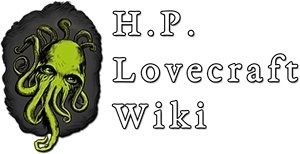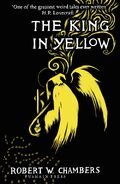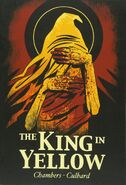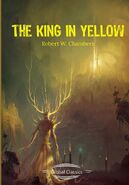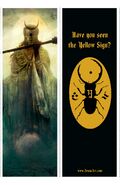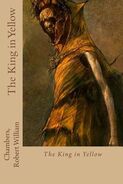- 🔀 You may be looking for the titular entity.
![]()
![]() The King in Yellow is a collection of short stories written by Robert W. Chambers and published in 1895. The stories could be categorized as early horror fiction or Victorian Gothic fiction, but the work also touches on mythology, fantasy, mystery, science fiction and romance. The first four stories in the collection involve a fictional two-act play of the same title: The King in Yellow.
The King in Yellow is a collection of short stories written by Robert W. Chambers and published in 1895. The stories could be categorized as early horror fiction or Victorian Gothic fiction, but the work also touches on mythology, fantasy, mystery, science fiction and romance. The first four stories in the collection involve a fictional two-act play of the same title: The King in Yellow.
Chambers' book borrows elements from the supernatural stories of Ambrose Bierce and weaves them into a new lore, which would in turn be incorporated into the Cthulhu Mythos by authors such as H. P. Lovecraft, August Derleth, and Hugh B. Cave, among others.
Stories[]
The first four stories are loosely connected by three main devices:
- A two-act stage play in book form entitled The King in Yellow.
- A mysterious and malevolent supernatural entity known as the King in Yellow (associated in some way with Hastur).
- An eerie symbol called the Yellow Sign.
The color yellow signifies the decadent and aesthetic attitudes that were fashionable at the turn of the 19th century, typified by such publications as The Yellow Book, a literary journal associated with Oscar Wilde and Aubrey Beardsley. It has also been suggested that the color yellow represents quarantine — an allusion to decay, disease, and specifically mental illness. For instance, Charlotte Perkins Gilman's famous short story "The Yellow Wallpaper", involving a bedridden woman's descent into madness, was published shortly before Chambers' book.
These stories are macabre in tone, centering on characters that are often artists or decadents. The first story, "The Repairer of Reputations", is set in an imagined future 1920s New York City, whose history, being at odds with the knowledge of the reader, adds to the effect of its unreliable narrator. The next two are set in Paris, while the fourth, "The Yellow Sign", is again set in New York.
The other stories in the book do not follow the macabre theme of the first four, and most are written in the romantic fiction style common to Chambers' later work. Some are linked to the preceding stories by their Parisian setting and artistic protagonists.
List of stories[]
The stories present in the book are:
- The Repairer of Reputations
- The Mask
- In the Court of the Dragon
- The Yellow Sign
- The Demoiselle d'Ys
- The Prophets' Paradise
- The Street of the Four Winds
- The Street of the First Shell
- The Street of Our Lady of the Fields
- Rue Barrée
The Play The King in Yellow[]
The fictional play The King in Yellow has two acts, and at least three characters: Cassilda, Camilla, and the Stranger. The titular King in Yellow is generally assumed to appear in the play as well (at one point, Cassilda cries "Not upon us, oh King, not upon us!"), and may or may not be the same as the Stranger. Chambers' story collection excerpts sections from the play to introduce the book as a whole, or individual stories. For example, "Cassilda's Song" comes from Act I, Scene 2 of the play:
- Along the shore the cloud waves break,
- The twin suns sink beneath the lake,
- The shadows lengthen
- In Carcosa.
- Strange is the night where black stars rise,
- And strange moons circle through the skies
- But stranger still is
- Lost Carcosa.
- Songs that the Hyades shall sing,
- Where flap the tatters of the King,
- Must die unheard in
- Dim Carcosa.
- Song of my soul, my voice is dead;
- Die thou, unsung, as tears unshed
- Shall dry and die in
- Lost Carcosa.
The short story "The Mask" is introduced by an excerpt from Act I, Scene 2d:
- Camilla: You, sir, should unmask.
- Stranger: Indeed?
- Cassilda: Indeed, it's time. We have all laid aside disguise but you.
- Stranger: I wear no mask.
- Camilla: (Terrified, aside to Cassilda.) No mask? No mask!
All of the excerpts come from Act I. The stories describe Act I as quite ordinary, but reading Act II drives the reader mad with the "irresistible" revealed truths. “The very banality and innocence of the first act only allowed the blow to fall afterward with more awful effect.” Even seeing of the first page of the second act is enough to draw the reader in: “If I had not caught a glimpse of the opening words in the second act I should never have finished it [...]” ("The Repairer of Reputations").
Chambers usually gives only scattered hints of the contents of the full play, as in this extract from "The Repairer of Reputations":
| “ | He mentioned the establishment of the Dynasty in Carcosa, the lakes which connected Hastur, Aldebaran and the mystery of the Hyades. He spoke of Cassilda and Camilla, and sounded the cloudy depths of Demhe, and the Lake of Hali. "The scolloped tatters of the King in Yellow must hide Yhtill forever," he muttered, but I do not believe Vance heard him. Then by degrees he led Vance along the ramifications of the Imperial family, to Uoht and Thale, from Naotalba and Phantom of Truth, to Aldones, and then tossing aside his manuscript and notes, he began the wonderful story of the Last King. | „ |
A similar passage occurs in "The Yellow Sign", in which two protagonists have read The King in Yellow:
| “ | Night fell and the hours dragged on, but still we murmured to each other of the King and the Pallid Mask, and midnight sounded from the misty spires in the fog-wrapped city. We spoke of Hastur and of Cassilda, while outside the fog rolled against the blank window-panes as the cloud waves roll and break on the shores of Hali. | „ |
Behind the Mythos[]
The mythology of The King in Yellow is partially derived from the stories of Ambrose Bierce, most notably "An Inhabitant of Carcosa", which introduces the titular city, and briefly mentions Aldebaran and the Hyades. However, some of Bierce's concepts are re-imagined or re-contextualised by Chambers. For instance, Hastur originates from Bierce's story "Haïta the Shepherd", which portrays it as a god, whereas several references in The King in Yellow suggest that Hastur is a place, and one of the stories ("The Demoiselle d'Ys") uses it as the name of a human character. Similarly, Hali was originally a character, possibly an occultist or philosopher, quoted by Bierce in "An Inhabitant of Carcosa" and "The Death of Halpin Frayser". In The King in Yellow, Hali is the name of a lake.
Elements from The King in Yellow were associated with the Cthulhu Mythos by H. P. Lovecraft in The Whisperer in Darkness, which mentions Hastur, the Lake of Hali, and the Yellow Sign. Hastur would go on to take a much more central role in the stories of August Derleth, who portrays it as a Great Old One dwelling in the Lake of Hali, in an alien world near Aldebaran in the Hyades, which Derleth associates with the black stars mentioned in Chambers' book.
